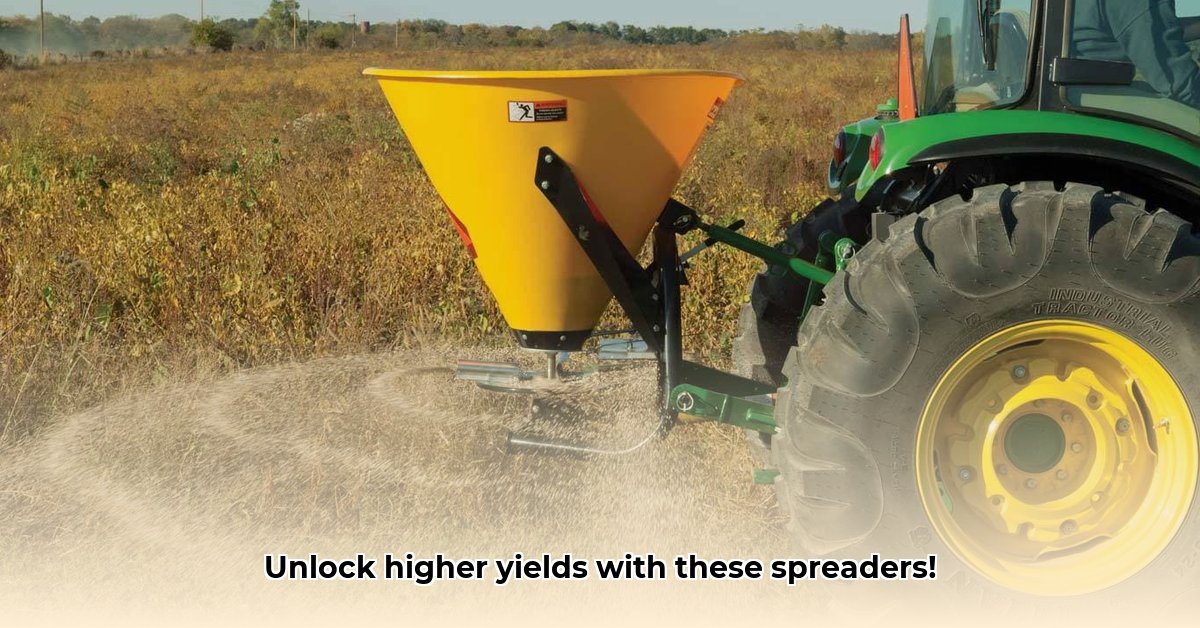
Efficient fertilizer application is paramount for maximizing crop yields while minimizing environmental impact. This guide provides actionable steps for selecting, calibrating, maintaining, and effectively utilizing tractor-mounted fertilizer spreaders, focusing on achieving sustainable agricultural practices. For more on tractor equipment, see this helpful resource: tractor resources.
Choosing the Right Fertilizer Spreader: A Tailored Approach
Selecting the appropriate fertilizer spreader depends on several factors: farm size, terrain, crop types, and budget. Different spreader types offer unique advantages and disadvantages. A poorly matched spreader can lead to significant fertilizer waste and suboptimal yields. What's the best spreader for your operation?
Centrifugal Spreaders: These spreaders use spinning discs to disperse fertilizer. They are generally inexpensive and easy to maintain, but accuracy can be lower, resulting in potential fertilizer waste. Suitable for large, relatively flat fields with less stringent application rate requirements.
Spinner Spreaders: Offering improved accuracy compared to centrifugal spreaders, spinner spreaders often include adjustable controls for better distribution. They are versatile and suitable for larger fields and uneven terrain.
Broadcast Spreaders: Designed for even distribution across large areas, broadcast spreaders are simple and efficient for flat fields. However, they lack the precision needed for variable-rate application or uneven terrain.
Pneumatic Spreaders: Employing air pressure for precise fertilizer delivery, these spreaders offer exceptional accuracy and are ideal for variable-rate application, minimizing waste. While highly efficient, they represent a greater upfront investment and maintenance complexity.
Consider the following table to aid in your decision:
| Spreader Type | Advantages | Disadvantages | Ideal Applications |
|---|---|---|---|
| Centrifugal | Low cost, easy maintenance | Lower accuracy, potential fertilizer waste | Large, flat fields, less precise application needs |
| Spinner | Improved accuracy, versatile | Higher cost than centrifugal | Larger fields, uneven terrain, moderate precision |
| Broadcast | Simplicity, cost-effective | Least precise, unsuitable for uneven terrain | Large, uniform fields, basic application needs |
| Pneumatic | High precision, variable-rate application | High initial cost, complex maintenance | Precision farming, varied application rates |
Don't forget to factor in the cost of GPS guidance systems which can greatly enhance the precision of spinner and pneumatic spreaders.
Calibrating Your Fertilizer Spreader: The Key to Precision
Accurate calibration is crucial for optimizing fertilizer use and minimizing environmental impact. Improper calibration leads to wasted resources and potentially harms the environment. How effectively are you spreading your fertilizer?
Follow these steps to calibrate your spreader:
Measure Spreader Output: Spread fertilizer over a known area (e.g., 100 sq ft), carefully collect and weigh the dispensed fertilizer.
Calculate Application Rate: Divide the weight of fertilizer (in pounds) by the area covered (in acres) to determine the application rate (lbs/acre).
Adjust Settings: Consult your spreader's manual to adjust settings to achieve your target application rate. Remember that settings may vary depending on the type and density of fertilizer.
Verify Calibration: Repeat steps 1-3 to ensure accuracy. Slight variations are acceptable, but significant differences indicate a need for readjustment.
Regular recalibration is essential, especially after maintenance or when switching fertilizer types. Consistent calibration ensures optimal fertilizer distribution.
Maintenance and Best Practices: Ensuring Long-Term Performance
Proper maintenance extends the life of your fertilizer spreader and ensures continued accuracy. Neglecting maintenance can impact the equipment's precision and longevity. What's your maintenance routine?
Clean Thoroughly: Clean the spreader after each use to prevent fertilizer buildup and clogging.
Inspect Regularly: Inspect for wear and tear on moving parts, belts, and other components. Replace worn parts promptly.
Lubricate as Needed: Properly lubricate moving components according to the manufacturer's recommendations.
Follow Manufacturer's Instructions: Adhere to the manufacturer's scheduled maintenance recommendations for optimal performance.
Beyond equipment maintenance, consider these best practices:
Soil Testing: Regular soil testing identifies nutrient deficiencies, guiding fertilizer application and reducing waste.
Optimal Timing: Apply fertilizer at the optimal time for your specific crops and local conditions. Consult local agricultural extension services for guidance.
Correct Fertilizer Selection: Use fertilizers formulated for your crops and soil type.
Sustainable Fertilizer Application: Balancing Yield and Environmental Stewardship
Efficient fertilizer use minimizes environmental impact and promotes sustainable agriculture. Precision techniques, coupled with careful planning, lead to reduced fertilizer waste and runoff. Are you practicing sustainable fertilizer application?
Precision agriculture technologies, such as GPS-guided spreaders and variable-rate application systems, enable optimized fertilizer distribution, targeting nutrient application based on soil nutrient levels and crop requirements. These advancements minimize fertilizer waste and reduce environmental consequences. By accurately assessing your needs and properly calibrating your equipment, you directly contribute to sustainable agriculture while simultaneously maximizing your yield potential. The integration of precision technology into your operations reflects a commitment to environmentally responsible farming and efficient resource utilization.